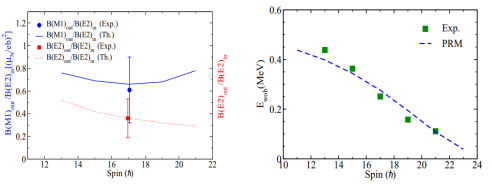The wobbling motion is a clear fingerprint of stable triaxial shapes of nuclei. Since the transverse wobbling motion was firstly proposed by theoretical physicists in 2014, numerous studies have been performed by scientist. However, the barium-130 is the only reported transverse wobbler in even-even nuclei until now. Very little is known about this phenomenon.
In the new study, researchers proposed to search for the other transverse wobbler in even-even nuclei of the A~130 mass region. The experiment was carried out using the JUROGAM II + RITU + GREAT array at the University of Jyvaskyla, Finland. Equipped with 24 Clover detectors and 15 tapered detectors, the JUROGAM II spectrometer can collect very high statistics, which ensures the precision measurement of linear polarization.
Researchers found that the measured experimental information on two medium spin bands of neodymium-136 clearly indicates their transverse wobbling character. To further investigate the nature of these bands, a Romanian theory scientist developed a new particle-rotor model, with which he obtained calculations results that are in very good agreement with experimental results, thus confirming the transverse wobbling character of the bands.
The study provides the second case of transverse wobbler in even-even nuclei, helping us understand the existence of stable triaxiality at medium spin in nuclei more deeply.
This work was supported by the Special Research Assistant Project of CAS and the Strategic Priority Research Program of CAS.

Figure. Comparison between the experimental data (symbols) and calculation results of PRM (lines) for the wobbling bands of neodymium-136. (Image from Physical Review C)
Contact:
LIU Fang
Institute of Modern Physics

